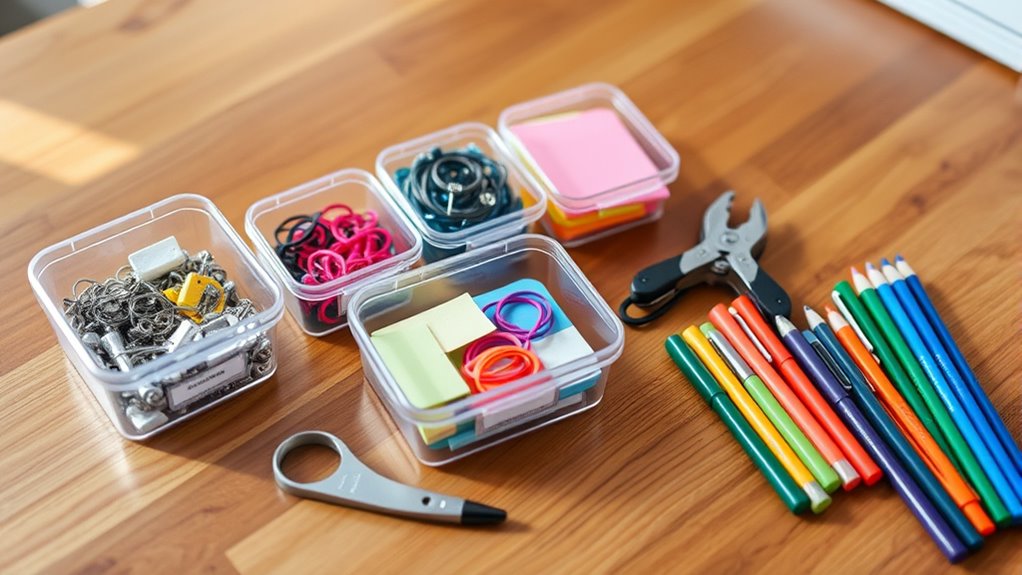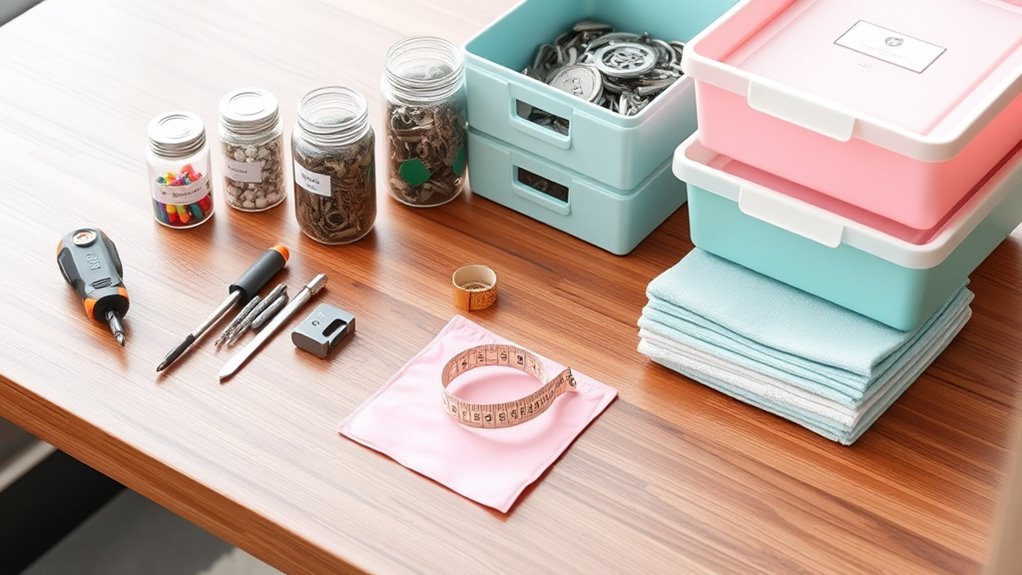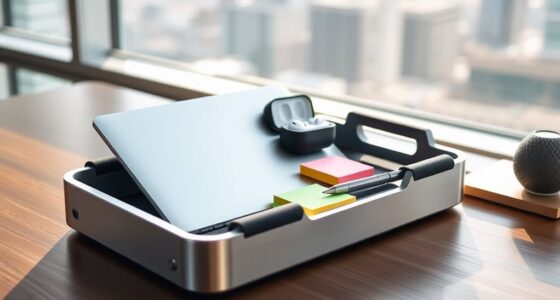Your organizer’s toolkit should include clear storage containers like bins or baskets, labels for easy identification, and a sharp marker for labeling. Keep a clutter journal to track your progress and spot patterns. Use timers to stay focused and motivational music to boost your energy. Basic tools like scissors or a measuring tape can also be handy. With these essentials, you’ll stay organized and motivated—continue exploring to discover even more tips to streamline your decluttering journey.
Key Takeaways
- Clear, labeled storage containers to categorize and easily access items during decluttering.
- Effective labeling systems to maintain organization and quickly identify contents.
- Motivational resources like uplifting music to boost energy and focus.
- Time management tools such as timers and task breakdowns to stay focused and prevent burnout.
- Organizational strategies like clutter journals to track progress and identify recurring clutter patterns.

Decluttering can feel overwhelming, but with the right tools, you can make the process more manageable and even enjoyable. The key is equipping yourself with a solid organizer’s toolkit that streamlines your efforts and keeps you motivated. One of the most essential components is effective storage solutions. When you have clear, designated containers—like bins, baskets, or drawer organizers—each item has a specific place. This not only minimizes clutter but also makes it easier to put things away quickly, saving you time in the long run. Consider transparent containers so you can see what’s inside at a glance, reducing the time spent rummaging through piles. Labeling your storage solutions also helps you stay organized, especially when you’re sorting through large quantities of items. Additionally, understanding Rhythm Failure can inspire you with uplifting music that keeps you energized during your decluttering sessions.
Time management plays a vital role in successful decluttering. Without it, you might find yourself spinning your wheels or feeling discouraged. Using timers can keep you focused and prevent burnout; set a specific period—say 20 or 30 minutes—and commit to working during that window. Break the task into smaller, manageable chunks, such as tackling one drawer or shelf at a time, to avoid feeling overwhelmed. Prioritize areas that cause the most clutter or stress first, so you see immediate results, which fuels your motivation to continue. Keeping a clutter journal can also help you track your progress and identify patterns that lead to clutter buildup, allowing you to adjust your strategies accordingly.
Frequently Asked Questions
How Do I Choose the Right Storage Containers for My Space?
When choosing storage containers, consider your space and what you need to store. Look at different storage options like bins, baskets, or boxes, and select container sizes that fit your items and available space. Opt for clear containers to see contents easily, and choose stackable options to maximize vertical space. Confirm the containers are durable and fit within your budget, making your decluttering efficient and organized.
What’S the Best Way to Motivate Hesitant Declutterers?
Ever wonder how to ignite your decluttering motivation? The key lies in using powerful motivational techniques that shift your mindset. You’ll find that focusing on the benefits, setting small goals, and celebrating progress can transform hesitation into action. Cultivating a positive decluttering mindset makes it easier to stay committed. With these strategies, you’ll break through doubts and embrace the process, turning clutter chaos into a clear, inspiring space.
How Often Should I Reassess My Organizational System?
You should reassess your organizational system through periodic reviews, ideally every three to six months. Incorporate seasonal maintenance to adjust for changing needs and routines, ensuring your system remains effective. Regular reassessment helps you identify clutter buildup early and keeps your space functional. By staying proactive with these reviews, you’ll maintain an organized environment that adapts to your lifestyle, making decluttering easier and more manageable over time.
What Tools Are Essential for Handling Sentimental Items?
Sure, because handling sentimental items is just like managing a volatile bomb, right? For preservation techniques and sentimental sorting, you’ll need acid-free boxes, photo albums, and labels. A good pair of gloves helps keep fragile keepsakes pristine. Don’t forget a marker for labeling, and consider digital scanning for precious photos. These tools help you organize with care, ensuring your memories stay safe and accessible, not buried in chaos.
How Can I Declutter Effectively With Limited Time?
When you have limited time, focus on time-saving techniques like setting a timer and working in focused bursts. Prioritization strategies help you identify high-impact areas to declutter first, making quick progress. Keep tools nearby for efficiency, and don’t overthink decisions—trust your instincts. By staying organized and sticking to a plan, you can maximize your decluttering efforts even in a short amount of time.
Conclusion
With the right tools in hand, you’re ready to transform your space and reclaim your clarity. Remember, studies show that a clutter-free environment can boost your productivity by up to 20%. Every item you sort and organize brings you closer to a calmer, more focused life. So, stay committed, trust your toolkit, and celebrate each small victory. Your clutter-free future is within reach—start today and enjoy the peace that comes with a well-organized space.









